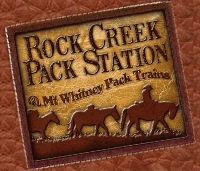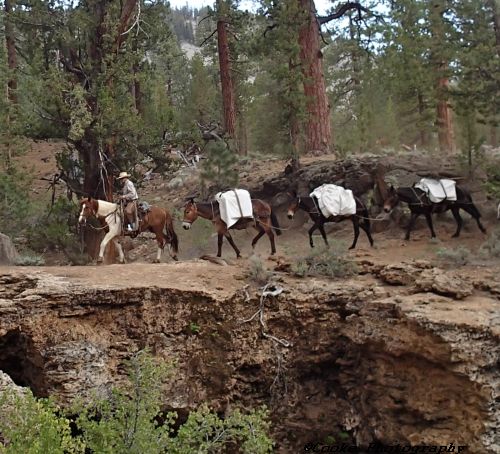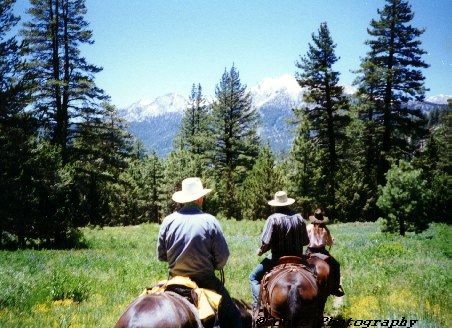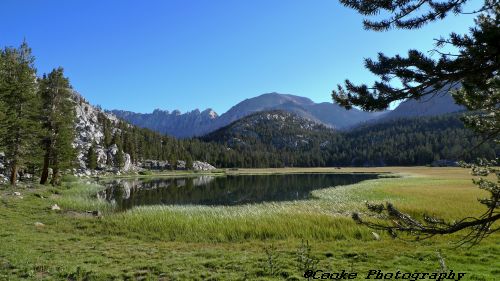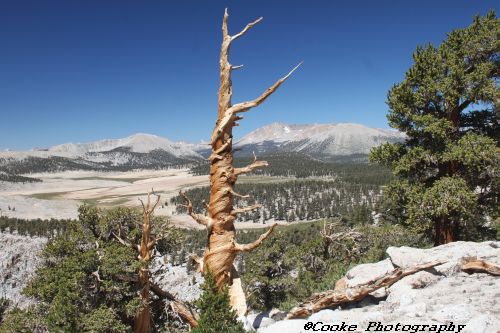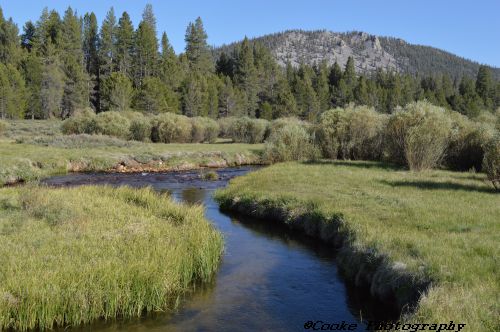Trip Overview:
Explore the Golden Trout Wilderness with a loop heading over Trail Pass into the meadows and stringers of the Kern Plateau. This is a secluded wilderness area with vast meadows and trails to explore. We make a loop with camps at Little Whitney and Big Whitney Meadows crossing both Barringer and Cottonwood Passes. Trails are good.
A great trip for those that enjoy riding and seeing lots of new country every day.
Itinerary:
Day 1: Cottonwood Pack Station to Kern Peak Stringer (11 miles)
The path drops 100 from the pack station to the Cottonwood Pass trail. Continue straight to cross Horseshoe Meadow toward Trail Pass. In one mile, the path will merge with a trail running along the east side of the meadow as it continues up 600 through forest to 10,500 Trail Pass and the junction with the Pacific Crest Trail. Enjoy views of the Golden Trout Wilderness before continuing straight, to drop 1,150 in 2.3 miles through open forest to the trail junction at Mulkey Meadow, a favorite lunch spot.
Continue straight across the Mulkey Pass/Tunnel Meadow trail toward Templeton Meadows. The trail stays close to the stream for 1.6 miles as it crosses Mulkey Meadow, before climbing 300 over a low ridge through open forest in 1.1 miles. The path drops 800 over the next 1.5 miles to the eastern end of Ramshaw Meadows. Leave the Mulkey/Templeton Meadows trail, turning right to follow the north side of Ramshaw Meadows toward Red Hill. Finally, cross the South Fork of the Kern River to the west side of the meadow as you approach Red Hill to find the Ramshaw/Templeton Meadows Trail. Turn right to follow the trail north for a mile to Junction 89
Day 2: LayoverRide up towards Kern Peak
Kern Peak (11.2 miles, 2,800 gain and loss )
Kern Peak is one of the most prominent points in the eastern section of the Golden Trout Wilderness. Those who reach the top are rewarded with stunning views of the Great Western Divide and the Sierra Crest towering above the Kern River drainage to the north, the Panamint Mountains beyond Owens Valley to the east, and, on very clear days, the mountains of Southern California to the south. Travel to the top or turn back along the way after enjoying the forest and meadows along the trail.
The base camps are near the Kern Peak trail. Have your packer show you how to access the trail rather than returning to Junction 8920 to start the trip. The Kern Peak trail follows the Kern Peak Stringer, crossing the creek and side creeks, as it climbs steadily through the forest. The trail may fade at times, but there are tree blazes to mark the way. The path eventually veers away from the creek to climb steeply in open terrain to Kern Peak.
Day 3: Kern Peak Stringer to Little Whitney Meadows
This a relatively short day of riding as we climb out of Ramshaw Meadows and ride to cross Golden Trout Creek below Tunnel Meadows. The trail follows Golden Trout Creek past Groundhog Meadow and past the Cinder Cone and ancient lava flows before arriving at Little Whitney Meadows.
Day 4: Little Whitney Meadows to Big Whitney Meadows (8.6 miles, 2,250 gain, 950 loss. )
Travel around the north side of Little Whitney Meadows to the trail that will follow Johnson Creek north, passing through Salt Lick Meadow before crossing to the east side of the creek. The trail climbs 1,900 in five miles to a saddle east of Johnson Peak before dropping 200 to the meadows of Barigan Stringer. Cross the creek to encounter two trail junctions. The first junction is the Rocky Basin Lakes Trail; go to the right. The second junction in just 0.1 miles is the Barigan Stringer Trail; go to the left toward Big Whitney Meadow to climb 200 over a low ridge before dropping 500 to the Siberian Pass junction at the edge of Big Whitney Meadow. Follow the trail east toward Cottonwood Pass 1/3 mile to our camp on the right side of the trail.
Day 5: Layover -ride to Siberian Outpost or to Rocky Basin Lakes
Riding north up to Siberian Pass gives riders the opportunity to see the Borreal Ridge. Looking north we see the barren Siberian Outpost. Stunning views north to the Great Western Divide and Mt. Whitney. Or, those wanting a longer ride may want to head to Rocky Basin Lakes.
Day 6: Big Whitney Meadows to Cottonwood Pack Station
Time to head home by traveling up Stokes Stringer and riding through Forests and streams to reach Cottonwood Pass. We descend to Horseshoe Meadows to reach Cottonwood Pack Station
Please note that this represents the planned itinerary. Weather or other factors may affect the choice of campsites and daily travel. All decisions are made by the Head Packer with attention to the safety and comfort of guests and stock.
WHAT YOU NEED TO KNOW.. for riders
OUR SERVICES
We supply horses, saddles, food, kitchen and eating utensils, and camping equipment. Tents will be provided. Private tents for couples or families will be reserved by request. Food will be plentiful and deluxe in quality. We provide the preparation of meals; any help is appreciated but not mandatory. Those desiring to learn how to pack may participate in making up loads and packing the mules.
IMPORTANT INFORMATION
- Check-in time is 7 a.m. at Rock Creek Pack Station except when OTHER LOCATION is specified.
- Free parking for guests' cars at pack station.
-
Breakfast is served the first day while the mules are being loaded.
The last meal furnished is lunch the last day.
- We provide a small saddle bag for trail necessities. Please do not bring your own saddle bags or day packs unless they
are pocket size. Participants may not carry large camera
cases with extra lenses on the saddle. If you have extra camera equipment, it can be packed in your duffel or in a
safe place on mules.
-
You will be limited to 3 lbs. in the saddle bag, which includes your lunch.
Your jacket and rain gear are not included in the 3 lbs. and may be tied on the back of the saddle. No day packs allowed on riders' backs.
- Each person is assigned a horse for the duration of the trip with regard to the guest's weight, height, and ability.
- Dunnage limit is 30 lbs. per person (this includes sleeping bags, fishing equipment, liquor, etc.).
There will be a surcharge of $3 to $10 per pound on dunnage in excess of the 30 lbs. You may bring your own tent if under 10 lbs. which will not be included in 30 lb. weight limit.
- Trip fee does not include alcoholic beverages or lodging night before and after trip.
- Gratuities are optional and a personal choice.
- Trip will terminate in the late afternoon of last day.
- Free shuttle back to Rock Creek Pack Station for trips terminating at other road heads.
- Reservation form must be accurately completed.
The information on age, height, weight and riding ability is used to assign riding animals. Failure to provide accurate information may result in the participant being denied going on the trip with loss of trip fee.
- We advise guests to purchase cancellation and trip travel insurance.
- Participants will be sent an assumption of risk and a liability release form. All guests must assume the risk and sign the forms before using Rock Creek's service. Our forms have excellent guidelines for riding safety that we ask you to study.
- The pack station does not boil or treat water. Campsites are remote enough that we feel safe in using the water. It you want to purify water bring your own filter pump or purification tablets.
PERSONAL CHECK LIST
Bring belongings in stout canvas or nylon duffels; side zipper recommended, ideal size approximately 14" x 32".
It is a good idea to use a large plastic bag INSIDE of the duffle to protect contents from external moisture.
Sleeping bags can be in separate duffels --again, line the inside of the duffle against rain.
Place all cosmetics, soaps, medications, etc into small plastic containers with close-fitting caps,
THEN into sturdy resealable plastic storage bags.
If anything breaks or bursts from altitude changes, the plastic bag contains the spill.
When possible, it is a good idea to transfer alcoholic beverages to sturdy plastic bottles with well fitting caps - it will save weight and protect against breakage.
Check in fishing worms and bottle goods separately; don't put in duffel. Place fishing rods in metal or plastic cases.
You will be given a small saddle bag that goes on your saddle horn to carry your lunch and a few personal items. (Weight limit 3 lbs - including lunch).
Remember - try to minimize the weight of your dunnage by packaging only
the amount of any item you will need (like soaps, lotions and medications).
RECOMMENDED ITEMS:
- Sleeping bag with a comfort range of 20 to 60 degrees and a moisture proof ground cloth.
- Air mattress or small 1/4"-1/2" foam hip pad recommended - your night's rest will affect your next days enjoyment.
Bring the best sleeping pad you can manage.
- Broad-brimmed hat is essential for protection from sun at high altitude. It must have strings to keep from blowing off.
- Sunglasses (RX glasses) - high altitude sun is BRIGHT!
- Coffee mug (plastic for camp)
- Pint water bottle for your horn bag
- Pocket knife or small multi-tool
- Flashlight and extra batteries
- Camera and film (sturdy strap)-- if using digital - don't forget an extra battery and card
- Rain jackets and pants or slicker (rolled up you can tie them to the back of your saddle)
- Hat protector (to keep your hat dry)
- Light jacket (windbreaker)
- Wool or fleece pullover/sweater (layers will keep you comfortable)
- Heavy jacket
- Bandana
- Woolen cap (evenings can be cold)
- Gloves (recommend gloves for riding, may want warm gloves for evenings)
- Socks
- Riding boots
- Shoes for camp (moccasins, athletic shoes, etc)
- Shirts and pants (long sleeved shirts offer sun, bug and branch protection)
- Underwear
- Bathing suit
- Bath towel/wash cloth/soap (try a multi-use bar or liquid for use on hair, body and laundry. Biodegradable choices are available.)
- Insect repellent such as Cutters
- Toothbrush/toothpaste
- comb/brush clips/pins/ponytail holders
- Shaving kit (a small mirror is helpful)
- Sun Screen (lotion, cream or stick)- use liberally for sunburn and chapping prevention.
- Chapstick with sun protection SPF 15 or better
- Moisturizer (cream or lotion - altitude and sun can be dry and chap skin)
- Prescription medicine (if required - if you have any allergies, remember to bring appropriate medication)
- Band-aids, aspirin, ibuprofen, eye drops, moleskin for any blisters
- Baby powder/Talcum powder (helps to relieve any raw or irritated areas from boots, clothes or saddles)
- Kleenex
- Jogging suit (sweats are comfortable for after-swim and campfire lounging)
OPTIONAL ITEMS:
- Small notepad and pencil
- Collapsible plastic wash basin (optional)
- Solar shower (optional)
- Water filtering pump (optional)
- Liquor (be sure to check in with the packers to see that your liquor is packed safely)
- Fishing equipment (optional)
- CALIFORNIA FISHING LICENSE. Please note that fishing licenses are NOT available at or near the pack station. Be sure to get one BEFORE you arrive for your adventure. You can find information on California fishing licenses and online purchase at TakeMeFishing.org. You can purchase them at a Bishop sporting goods store, as well.
- Rod/reel/line (a rod that breaks down into 3 or more pieces is recommended)
- Compact metal rod case to carry on saddle
- Canvas creel (no tackle boxes)
- Leader material (1-3 lb.)
- Flies: black gnat, mosquito, grey hackle, brown hackle, & royal coachman (No. 12-14 hooks)
- Bait: worms & Pautzke red eggs
- Egg hooks, worm hooks (No. 10-14)
- Split shot
- Lures (personal choice)
- Pliers
LOW-IMPACT GUIDE FOR THE WILDERNESS USER
We are dedicated to conducting our trips so that others following us will find the country unspoiled. Livestock is a natural part of the wilderness and when properly managed enhances man's enjoyment of our unmechanized wilderness area. Today, just as it was when the entire west was mostly wilderness, the horse and mule remain our companions and servants in wilderness travel. We practice and expect you to observe the following during your trip.
- Keep horses on trail; do not cut switchbacks (corners).
- Tie horses 200 feet away from streams, trails and campsites. At camps, horses and mules are tied to picket lines,
stretched between trees on granitic soil.
- If you can't tie animal to picket line use a tree greater than 8" in diameter, not on grass. Tie high and short (2-3 ft.) so horse doesn't get foot caught in rope.
- Choose a tent site at least 100 ft. from water (THE LAW) where drainage will not be a problem, avoiding the need to trench. No tents or camp area allowed on grass or meadowlands.
- Utilize pre-existing fire rings where possible. Don't surround fires with rocks! Dig a hole in sand and cover when finished. When you leave camp, bury ashes from fire rings. Leave existing fire rings clean for the next user.
- When breaking camp, return the spot to its natural state and broadcast a covering of needles and cones. Scout the area to make sure nothing will be left behind. Remove the smallest pieces of aluminum foil and trash.
- Pack out all trash. Don't bury garbage, scatter organic wastes or leave foil in campfire pit. Burn cans and flatten. On our group trips we have a bag for cans and aluminum foil.
- Don't use soap (even biodegradable) in streams or lakes, Wash yourself, clothes and dishes away from water sources.
- Bury human waste 200 ft. from water, campsites and trails. Dig a hole 4-6" deep and after use tamp with sod.
- Don't pick flowers or cut branches from live trees. Use only downed wood for fires.
- You are required to keep bears from getting to your food at all times. Please ask for current regulations and suggestions on how to prepare for your trip.
MAPS
TOM HARRISON MAPS.
Tom Harrison Maps, paper or download onto phone/tablet:
- Golden Trout Wilderness
- Mt. Whitney High Country
Apps for Smartphone/Tablet, download applicable areas prior to departure:
